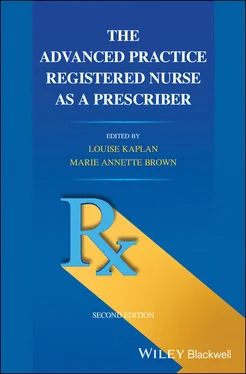One of the most challenging aspects to prescribing can occur when patients have strong, erroneous, or unrealistic beliefs about their care. Some patients may be demanding, complaining, or rude, and require more extensive interaction than other patients. While these situations may prompt the label of “difficult patient,” alternative terminology such as “difficult patient situations” or “complex patient interactions” is more appropriate. “Standing one’s ground” with rational prescribing can be difficult in the face of patients’ demands for specific medications such as antibiotics. How can the APRN handle situations in which the patient assumes an adversarial role? Chapter 6, Managing Difficult and Complex Patient Interactions, has a full discussion of this topic. There are times, however, when a patient’s specific medication request may be appropriate to consider. For example, when the next step in treatment of depression is medication, a patient may request the specific drug a family member had success with. Provided there are no contraindications to that specific drug and there is not a superior option, working with the patient’s preference can build rapport.
SPECIAL CONSIDERATIONS FOR PRESCRIBING
Overview
APRNs have clinical competencies to provide healthcare for diverse populations in diverse settings which include emergency departments, primary care clinics, retail clinics, extended care facilities, prisons, and hospitals. APRNs also work in specialties such as oncology, geriatrics, dermatology, rheumatology, orthopedics, nephrology, cardiology, and palliative care. The prescribing role will be influenced by factors such as national certification and licensure, the population focus or specialization, the setting, and the community.
Prescribing for specific populations
Many psychiatric mental health NPs work with children. There are few medications approved by the FDA for use with children with mental health problems including depression, bipolar disorder, and schizophrenia. Conversely, there is an abundance of CSs marketed to treat children with attention deficit hyperactivity disorder (ADHD). This may lead parents to request these medications for behavioral issues even if the APRN does not diagnose ADHD.
The neonatal, pediatric, and family NP and pediatric CNSs may prescribe medication for children. Prescription challenges in this population sometimes involve calculating doses based on weight. As a vulnerable population, there is limited research on medication use in children. Consequently, a great deal of prescribing for children is not FDA approved and is known as “off label.” Factors such as size, age, renal function, cardiac output, hepatic blood flow, and genetics affect pharmacokinetics and pharmacodynamics among children. Pediatric prescribing must consider various factors such as absorption of drugs, drug distribution, drug metabolism, and drug elimination (Garzon Maaks et al., 2020). Over‐the‐counter medications for children pose potential risks. Cold and cough preparations have not been adequately studied and are not recommended for children younger than six years of age (Lowry & Leeder, 2015). For example, excessive acetaminophen is associated with hepatic toxicity and use of aspirin during a viral infection may induce Reyes syndrome. It is critical therefore to routinely educate parents about seeking APRN guidance before using over‐the‐counter medications with children.
Adult gerontology primary and acute care NPs often work with patients who have polypharmacy complicated by mental and physical deficits. Polypharmacy increases the complexity of therapy, increases costs, and increases the risk of adverse consequences. As previously noted, use of the Beers Criteria and the STOPP screening tool can enhance rational prescribing.
The types of drugs that CRNAs order and administer have potentially serious and immediate consequences. For example, when propofol is used for sedation, the CRNA must be alert to the rapid onset of action, which is often within a minute. This rapid onset is dose‐dependent and can result in an impaired respiratory drive, cause apnea, and require airway management.
CNMs, CNSs, and NPs must constantly consider the potential teratogenic effects of drugs in pregnant women. They must also consider the safety of drugs in lactating women. There are few randomized controlled trials regarding the safety of medications during pregnancy and lactation. To address this, the safety of medications is rated based on what information is available. Often the safety of a drug is unknown, and the APRN must proceed with caution and respond with evidence to the patient about her perception of risks and benefits.
NPs, CNSs, and CRNAs who work in pain management and palliative care typically prescribe a wide variety of CSs. Pain management requires expertise both in selecting medications and in dealing with patients who request medications that may not be indicated. Compliance with state laws implemented to deal with the US opioid crisis is imperative to assure patient safety and protect the APRN’s license (see Chapter 7). In contrast, APRNs who work with patients in palliative care may need to provide education to dispel concerns about opioid addiction at the end of life.
Other special considerations
An employer or health system may restrict APRN prescribing more than the law does. The VA and health maintenance organizations such as Kaiser Permanente use preferred drug lists, or formularies, to promote evidence‐based prescribing and control costs. Similarly, Medicaid and Medicare set guidelines for drug benefits, while private health plans usually have different tiers of drug coverage to promote prescribing of effective lowest cost drugs.
Pharmacy benefit managers are another aspect of the medication distribution chain, negotiating with drug companies and pharmacies on behalf of health plans. They develop formularies on behalf of the health plans, negotiate discounts and rebates with the manufacturers, and contract with pharmacies to reimburse for drugs dispensed to health plan beneficiaries (Commonwealth Fund, 2019). Some retailers have drugs dispensed for reduced costs, such as a $4 or $10 prescription, or offer reduced rates based on membership (Torrey, 2019). Discount coupons are often available from the manufacturer for some high‐cost medications or discount programs.
THE FUTURE OF THE APRN PRESCRIBING ROLE
The US opioid epidemic, increasing antibiotic resistance, the escalating costs of prescription drugs, and limited access to medication in under resourced countries are a few examples of why rational prescribing is imperative. A balance between pharmacological and non‐pharmacological treatment options is becoming increasingly desirable as many patients use herbal remedies and supplements and seek more holistic healing approaches, choosing to avoid medication risks and side effects. New scientific information may also reveal additional considerations about medication safety or sequelae. The APRN has the opportunity to meet these demands using evidence‐based practices and rational prescribing. As the evidence base for pharmacological treatment changes and the use of electronic prescribing increases, the APRN must adapt prescribing practices. Adoption of the prescriber role is a career‐long process that requires vigilance and wisdom.
1 Abramson, E. (2015). Causes and consequences of e‐prescribing errors in community pharmacies. Integrated Pharmacy Research and Practice, 4(5), 31–38.
2 Agency for Healthcare Research and Quality. (2020) Medication errors and adverse drug events. Retrieved from https://psnet.ahrq.gov/primer/medication‐errors‐and‐adverse‐drug‐events. (Accessed 7 September 2020.)
Читать дальше












